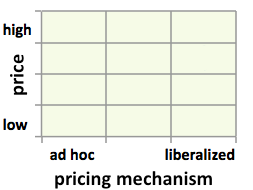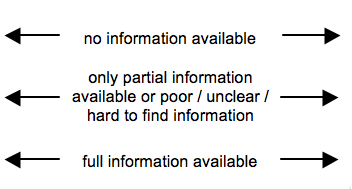Knowledge fuels change - Support energypedia!
For over 10 years, energypedia has been connecting energy experts around the world — helping them share knowledge, learn from each other, and accelerate the global energy transition.
Today, we ask for your support to keep this platform free and accessible to all.
Even a small contribution makes a big difference! If just 10–20% of our 60,000+ monthly visitors donated the equivalent of a cup of coffee — €5 — Energypedia would be fully funded for a whole year.
Is the knowledge you’ve gained through Energypedia this year worth €5 or more?
Your donation keeps the platform running, helps us create new knowledge products, and contributes directly to achieving SDG 7.
Thank you for your support, your donation, big or small, truly matters!
Difference between revisions of "Fuel Prices Iran"
***** (***** | *****) |
***** (***** | *****) |
||
| Line 1: | Line 1: | ||
{{Fuel Price Factsheet | {{Fuel Price Factsheet | ||
|Fuel Price Country=Iran | |Fuel Price Country=Iran | ||
| − | |Fuel Pricing Policies="Government controls and subsidizes fuel prices. Parliament ratified the Targeted Subsidies Reform Act in Mar 2010, calling for gradually increasing fuel prices to no less than 90% of the Persian Gulf FOB prices between 2010 and 2015, and similarly increasing natural gas, power, and water tariffs | + | |Fuel Pricing Policies="Pricing policy: Government controls and subsidizes fuel prices. Parliament ratified the Targeted Subsidies Reform Act in Mar 2010, calling for gradually increasing fuel prices to no less than 90% of the Persian Gulf FOB prices between 2010 and 2015, and similarly increasing natural gas, power, and water tariffs. The first price increase was implemented in Dec 2010, and introduced three different price levels for regular gasoline and two for diesel, depending on the consumer category. For regular gasoline, government vehicles and those used mostly in agriculture and industry were in the first price category until Jun 2011, after which this category was eliminated altogether; domestic vehicles with an engine size smaller than 2 liters in the second, with the engine size reduced to 1.8 liters in Jan 2013; and all others in the third. For diesel, public transport and industry are in the second category and others in the third. There is a quota for each category, depending on vehicle type, size, and location. The large price increases invited much criticism from Parliament, which in 2012 amended the Targeted Subsidies Reform Act to change “no less than 90%” of FOB prices to “no more than 90%,” thereby turning price floors into ceilings and entrenching price subsidies. Parliament rejected the proposal to increase prices in 2012, and depreciating currency means that domestic prices are declining in real terms. Nevertheless, it is significant that price increases as large as the ones effected in Dec 2010 were not rolled back. Government combined an effective communication strategy with nationwide cash transfers to mitigate the adverse effects of price increases for petroleum products, natural gas, electricity, and water. |
| − | For regular gasoline, government vehicles and those used mostly in agriculture and industry were in the first price category until Jun 2011, after which this category was eliminated altogether; domestic vehicles with an engine size smaller than 2 liters in the second; and others in the third. For diesel, public transport and industry are in the second category and others in the third. There is a quota for each category, depending on vehicle type, size, and location. In 2011, government did not target cash transfer to low-income households and instead paid 455,000 | + | |
| + | Social protection and compensation: To compensate for higher energy prices, the reform law authorizes using up to 50% of the savings from subsidy reduction for cash and in-kind payments to families, taking their income levels into account, and for a social security system; 30% of the savings to provide soft loans and credit lines to industries; and the remaining 20% to other government programs and infrastructure investment. In 2011, government did not target cash transfer to low-income households and instead paid Rls 455,000 (US$43 at the official exchange rate in 2011) a month to virtually all Iranians (about 73 million recipients), the total amount of which exceeded the savings from all the price and tariff increases of about Rls 30 trillion. Parliament in 2012 increased the allocation to cash transfers to families from 50% to 80%. | ||
| + | |||
| + | Effect on demand: The consumption of every fuel fell in 2011, led by a 36% drop for fuel oil, 11% for LPG, and 10% for diesel. Apparent consumption, however, increased markedly in 2012." | ||
(Source: Kojima, Masami. (2013, forthcoming). “Petroleum product pricing and complementary policies:Experience of 65 developing countries since 2009.” Washington DC: World Bank.) | (Source: Kojima, Masami. (2013, forthcoming). “Petroleum product pricing and complementary policies:Experience of 65 developing countries since 2009.” Washington DC: World Bank.) | ||
Revision as of 15:48, 25 March 2013
Part of: GIZ International Fuel Price database
Also see: Iran Energy Situation
Fuel Pricing Policies
| Local Currency: | IRR |
| Exchange Rate: | 10355
|
| Last Update: |
"Pricing policy: Government controls and subsidizes fuel prices. Parliament ratified the Targeted Subsidies Reform Act in Mar 2010, calling for gradually increasing fuel prices to no less than 90% of the Persian Gulf FOB prices between 2010 and 2015, and similarly increasing natural gas, power, and water tariffs. The first price increase was implemented in Dec 2010, and introduced three different price levels for regular gasoline and two for diesel, depending on the consumer category. For regular gasoline, government vehicles and those used mostly in agriculture and industry were in the first price category until Jun 2011, after which this category was eliminated altogether; domestic vehicles with an engine size smaller than 2 liters in the second, with the engine size reduced to 1.8 liters in Jan 2013; and all others in the third. For diesel, public transport and industry are in the second category and others in the third. There is a quota for each category, depending on vehicle type, size, and location. The large price increases invited much criticism from Parliament, which in 2012 amended the Targeted Subsidies Reform Act to change “no less than 90%” of FOB prices to “no more than 90%,” thereby turning price floors into ceilings and entrenching price subsidies. Parliament rejected the proposal to increase prices in 2012, and depreciating currency means that domestic prices are declining in real terms. Nevertheless, it is significant that price increases as large as the ones effected in Dec 2010 were not rolled back. Government combined an effective communication strategy with nationwide cash transfers to mitigate the adverse effects of price increases for petroleum products, natural gas, electricity, and water.
Social protection and compensation: To compensate for higher energy prices, the reform law authorizes using up to 50% of the savings from subsidy reduction for cash and in-kind payments to families, taking their income levels into account, and for a social security system; 30% of the savings to provide soft loans and credit lines to industries; and the remaining 20% to other government programs and infrastructure investment. In 2011, government did not target cash transfer to low-income households and instead paid Rls 455,000 (US$43 at the official exchange rate in 2011) a month to virtually all Iranians (about 73 million recipients), the total amount of which exceeded the savings from all the price and tariff increases of about Rls 30 trillion. Parliament in 2012 increased the allocation to cash transfers to families from 50% to 80%.
Effect on demand: The consumption of every fuel fell in 2011, led by a 36% drop for fuel oil, 11% for LPG, and 10% for diesel. Apparent consumption, however, increased markedly in 2012."
(Source: Kojima, Masami. (2013, forthcoming). “Petroleum product pricing and complementary policies:Experience of 65 developing countries since 2009.” Washington DC: World Bank.)
Fuel Prices and Trends
| Gasoline 95 Octane | Diesel | |
|---|---|---|
| in USD* |
|
|
| in Local Currency |
|
|
* benchmark lines: green=US price; grey=price in Spain; red=price of Crude Oil
Fuel Price Composition
Price composition.
No information available.
At a Glance
| Regulation-Price-Matrix |
| ||||
 |

|

|

| ||
Sources to the Public
| Type of Information | Web-Link / Source |
|---|---|
| Other Information | http://www.imf.org/external/pubs/ft/survey/so/2010/int092810a.htm |
Contact
Please find more information on GIZ International Fuel Price Database and http://www.giz.de/fuelprices
The following coordinate was not recognized: {{#geocode: Iran|google }}.



















